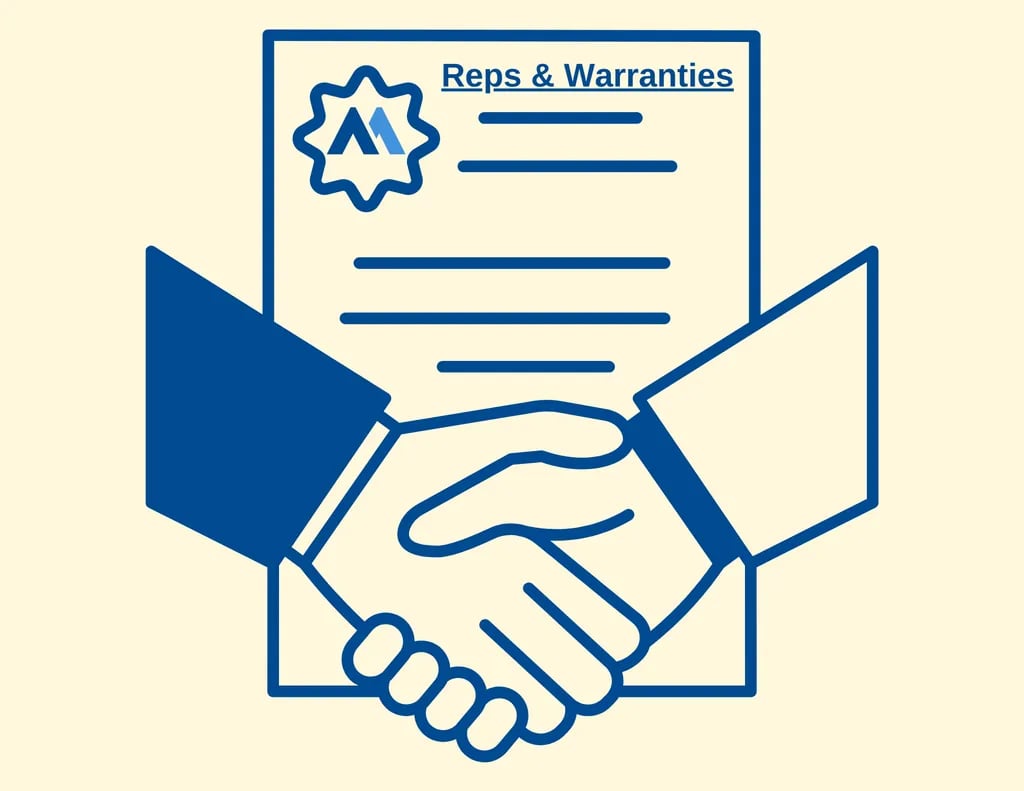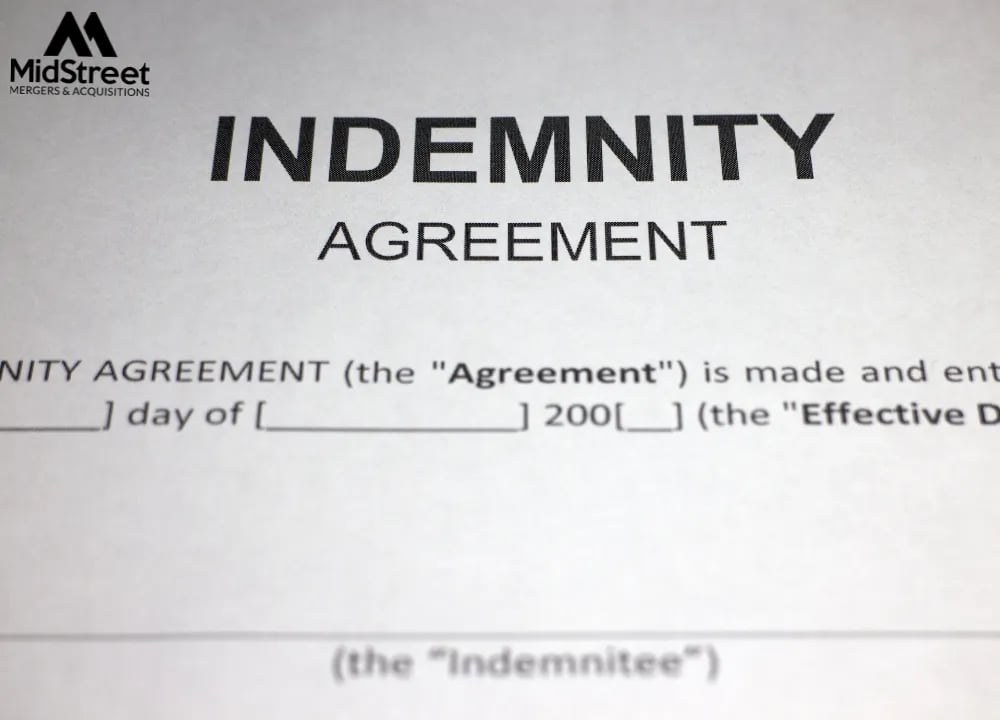Representations and Warranties in a Business Sale
If you’re thinking of selling your business, you have a vision for the future.
Part of that vision might be the fateful day when everything is settled, and your responsibilities as a business owner are finished.
It can be tempting to set your eyes on the closing date and think once the checks are cleared, so are your obligations related to the business.
While this is hopefully true for most sellers, it’s important to remember there are agreed upon terms called “representations and warranties” that survive closing.
Negotiating representations (reps) and warranties can be one of the most meticulous parts of selling a business because they determine whether the buyer or seller is liable for certain disputes that could arise after closing.
In this blog, we’ll define representations and warranties, talk about what happens if they’re breached, and offer a few tips to help you finalize them with as much peace of mind as possible.
Let's jump in!
Disclaimer: This content is not intended to provide legal and/or tax advice. Every business transaction is unique, and buyers and sellers should always consult with the appropriate professionals (attorneys and accountants) when considering a business acquisition/sale.
A Word on Indemnification
Throughout this blog, you will see the terms “indemnify, indemnifiable, and indemnified” used frequently.
To be indemnified simply means “to be paid back.”
Likewise, to indemnify means “to pay back.”
For the purposes of this blog, the “indemnifying party” is synonymous with the seller, and the “indemnified party” is synonymous with the buyer.
Any dispute that is “indemnifiable” stipulates an agreed upon repayment from the seller, whether this is financial (the seller owes the buyer money for the dispute) or legal (the seller must handle any indemnifiable litigation).
Reps and Warranties Defined

Representations (reps) and warranties are the facts and assurances about the conditions of a business presented by a business owner to a potential buyer.
You’ll run into reps and warranties while due diligence is being conducted, and will likely still be negotiating them right up until the purchase agreement is signed.
Reps and warranties are typically used together to refer to any assurances or statements of fact made about a business, but there are differences between the two.
Representations are statements about the business’s past and current conditions, including financials, inventory status, litigation, etc.
Warranties are assurances made by the owner regarding the sale and post-sale of the business including the training period.
Whereas representations can only present past and current statements of fact, warranties can be made regarding the future.
For example, a representation may state "all service contracts for manufacturing equipment are current," whereas a warranty may state "all service contracts for manufacturing equipment are valid for the next ten months."
While this distinction is something to note, reps and warranties are often used synonymously, and even the Universal Commercial Code (U.C.C.) blurs the lines between the two.
Typically, reps and warranties are made regarding the following:
- Financial Statements – a final audit on inventory, receivables, payables, etc.
- Assets – assurance that all agreed upon assets are being fully transferred to the buyer. This includes the conditions of hard assets like machinery, equipment, etc.
- Taxes – determine no assets have liens against them because of failure to pay taxes.
- Employee Relations – establish employee contracts, benefits, etc.
- Environmental Liabilities – addresses the possibility of environmental issues that could become a liability for the buyer even if contamination took place before their arrival.
- Pending and Potential Litigation – determines buyer and seller liability within a given time-frame of litigation or litigation risk associated with the company’s products, services, etc.
- Authorization – affirms the seller is authorized by any stockholders, partners, directors, etc. to sell the company.
It’s important to consider reps and warranties not just as statements of fact or assurances, but as the allocation of risk between buyer and seller.
For example, a buyer could ask a seller to make the representation that none of the business’s vendors have violated their contracts by entering into a contract with one of the seller’s competitors.
While this is an understandable request from the buyer, the seller can’t necessarily make this representation with 100% certainty. It’s always possible that vendors have violated their contracts without the seller knowing.
In this case, the representation could be made using language such as "to the seller's knowledge" no vendors have violated contracts. This language could protect the seller if a discovery was made post-acquisition that a vendor had violated a contract before closing.
For this reason, the buyer must decide if they are willing to agree to be indemnified only if "to the seller's knowledge" there were breaches of vendor contracts instead of being indemnified regardless of the seller’s knowledge.
This is why reps and warranties should be considered as an allocation of risk.
The buyer and seller must consider the risks and costs that could arise should the reps and warranties include (or fail to include) language that determines an indemnifiable misrepresentation.
Importance of Reps and Warranties
If the agreed upon reps and warranties determine the seller is liable for a dispute, the seller is obligated to compensate the buyer based on the terms defined in the purchase agreement.
By contrast, if the reps and warranties determine the seller can’t be held accountable, the buyer will have to incur the associated costs.
When negotiating reps and warranties, the buyer and seller (and their attorneys) must determine what kinds of disputes will require the seller to indemnify the buyer during the survival period after closing.
In other words, the seller will agree to “make good” on certain things if it is discovered that any of the reps and warranties the seller made were untrue.
Determining Factors: Survival Periods, Baskets & Caps, and Indemnity
Survival periods
The survival period of reps and warranties refers to the amount of time after closing in which a seller can be held liable for breaches of those reps and warranties.
This period is a negotiable item in the purchase agreement, so there isn’t necessarily a “typical” time frame. We’ve seen survival periods last for as little as a year or two after closing. We’ve also seen buyers request indefinite survival periods.
The survival period can become a big point of contention for sellers as they want to be free of any liability as soon as possible.
Ultimately, the length of the survival period depends on how the buyer views certain risks and what the seller thinks is reasonable.
Baskets
Baskets refer to the monetary threshold (usually .5% / .005 of the purchase price) that must be broken for the seller to be held responsible if a dispute arises.
Baskets don’t just apply to the amount of a single claim, meaning a buyer could uncover several small claims that break the basket threshold when added together.
For example, let’s say a buyer just purchased a business for $5 million.
The average basket for a purchase this size would be $25,000 ($5 million x .005 = $25,000). If one large claim, or an aggregate of smaller claims surpassed the $25,000 basket, the seller would be required to compensate the buyer for that amount.
Baskets are in place to give the seller a reasonable margin for error without being penalized. Like everything else in reps and warranties, this is also a negotiable item.
Something else that is up for negotiation is the type of basket that will be used: a tipping basket, or a deductible basket.
Tipping Basket
In a tipping basket, if the basket threshold is breached due to a misrepresentation, then the seller is responsible for the entire amount of cost incurred. For example, if the tipping basket is set at $30,000, and a breach of reps and warranties costs the buyer $35,000, then the seller will be responsible for the full $35,000 reimbursement.
Deductible Basket
In a deductible basket, the seller is only responsible for the amount exceeding the basket threshold. In the previous example with a $30,000 basket and a $35,000 cost to the new owner, the seller would only be responsible for the $5,000 exceeding the basket.
Whether you use a deductible basket or a tipping basket is a negotiating point that you will want to clarify before signing a purchase agreement.
Holdbacks
Oftentimes, a percentage (10%-20%) of the purchase price is held in escrow for an established time period for the buyer to access in the event of a dispute.
This is referred to as a “holdback,” and helps guarantee the buyer has access to the necessary funds to cover any losses that result from breaches of reps and warranties.
Once the survival period of the reps and warranties has ended, the seller will get back whatever amount is left in escrow. You can think of a holdback as somewhat of a security deposit made by the seller to be returned to them if there are few to no indemnifiable losses during the survival period.
Caps
A cap is the maximum amount for which the seller can be held liable if disputes arise after closing. Caps are usually determined as a percentage of the total purchase price, and vary greatly depending on the size of the deal.
For example, if a cap is set at 20% of the purchase price of $8 million, the maximum amount could be indemnified for would be $1.6 million ($8 million x .2 = $1.6 million). If, under the agreed upon reps and warranties, the total value of losses surpasses $1.6 million, then the buyer will have to incur the excess amount.
Language Matters

The language used when agreeing on reps and warranties is crucial in determining to what extent a party is held responsible.
The two types of language used in reps and warranties are referred to as Broad Nexus language, or Narrow Nexus Language.
Typically, the indemnifying party (the seller) will want the reps and warranties to include Narrow nexus language.
Narrow nexus language includes phrases like “solely resulted from” and “directly related to” as a part of reps and warranties made by the seller. Sellers prefer this because it narrows the scope of what they will be responsible for should a dispute arise.
Buyers, on the other hand, prefer that reps and warranties are written using broad nexus language.
Broad nexus language includes phrases like “in connection with” and “arising out of.” This broadens the scope of what the seller will be responsible for, which is more beneficial to the buyer should disputes arise in the future.
Whether a particular representation or warranty is written with broad or narrow nexus language ultimately comes down to what the buyer and seller (and their attorneys) are willing to negotiate and agree upon.
Simplify Reps and Warranties
Agreeing to reps and warranties is one of the most heavily negotiated portions of a business sale.
There’s no way around some of the strife involved, but there are a few things you can do to ease the process and remove some of the stress associated with it. To make this stage of the deal go as smoothly as possible, you should prepare for a thorough due diligence period, keep agreements reasonable, and understand the purchase agreement.
Good Due Diligence
Much of the turmoil associated with reps and warranties is preventable simply by conducting a thorough due diligence process.
While it’s true that not everything can be uncovered during due diligence, being thorough will help eliminate as many potential disputes as possible before a purchase agreement is signed.
Reasonable Agreements
It’s also important to make sure that the reps and warranties are reasonable. If a buyer is requesting too much from the seller, this can lead to feelings of distrust and annoyance, which can kill a deal.
Remember, there is no such thing as a risk-free deal. While it is smart to remove as much risk as possible, expecting the other party to incur all the risk just isn’t realistic.
Understand Your Purchase Agreement
Understanding the terms of your purchase agreement is ultimately what will help both parties prepare for what breaches and inaccuracies could lead to litigation or arbitration.
In some cases, these conditions are difficult to negotiate, which is why we recommend working with an experienced broker and a qualified attorney when settling on reps and warranties.
Reps and Warranties Insurance (RWI)
An increasingly popular trend in Mergers and Acquisitions (M&A) transactions is the use of Reps and Warranties insurance (RWI).
RWI is an attractive option for both buyers and sellers in a transaction for a few reasons.
RWI Benefits for Sellers
- It could reduce or eliminate the amount held in escrow after closing.
- It could narrow the criteria that determines a seller’s responsibility to cover losses, or eliminate their indemnity altogether.
- It allows for a smoother exit for the seller, removing certain liabilities associated with the sale.
- It can allow the seller to agree to more extensive reps and warranties requested by the buyer, removing some of the negotiation points in the purchase agreement.
RWI Benefits for Buyers
- The buyer’s offer can look more appealing to the seller if a holdback won’t be required (assuming the buyer relies on RWI for protection).
- It can allow for longer survival periods for reps and warranties, which protects the buyer for an extended period of time.
- Because sellers are willing to agree to more extensive reps and warranties if the buyer has RWI, buyers can feel confident that more of their claims will be covered.
- It can enhance coverage and provide greater caps than a seller may otherwise be willing to agree to.
While RWI was traditionally reserved for deals exceeding $100 million, there are now options available for business sales with transaction values as small as $250,000.
Understanding Reps and Warranties
Reps and warranties present some of the biggest negotiation points in a business sale.
Because of this, they come with a lot of nuanced language and several variables that depend on the size of the deal, and the amount of risk buyers and sellers are willing to assume.
Since so much regarding reps and warranties is negotiable, it can be tough to pin down any all-encompassing rules of thumb. The following, however, are things you want to keep in mind:
- Reps and warranties depend entirely on the size of a deal, and the allocation of risk between the buyer and seller.
- Hiring an attorney with M&A experience can help reduce your liabilities post-closing.
- A thorough due diligence process will remove as much of the headache associated with reps and warranties as possible.
- No deal is free of risks, so be reasonable in your expectations when agreeing to reps and warranties.
- Understanding your purchase agreement is the ultimate way to avoid any surprises or major losses after closing.
- RWI is an option to consider that could benefit both the buyer and seller.
At MidStreet, we’ve witnessed firsthand the negotiation of reps and warranties between buyers and sellers.
If you’d like to learn more about what reps and warranties include, or have any other general questions, contact us today. We’d be glad to help!





